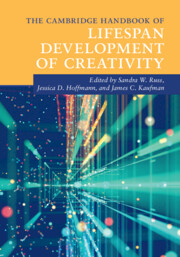Book contents
- The Cambridge Handbook of Lifespan Development of Creativity
- The Cambridge Handbook of Lifespan Development of Creativity
- Copyright page
- Dedication
- Contents
- Figures
- Tables
- Contributors
- Acknowledgments
- Introduction
- Part I Core Concepts of Lifespan Creativity Development
- Part II The Development of Creativity
- 5 Are Preschoolers Creative?
- 6 Development of Creativity in School-Age Children
- 7 The Development and Enhancement of Adolescent Creativity
- 8 The Intertwined Development of Identity and Creativity
- 9 Creative Development in Children from a Measurement Perspective
- 10 Creativity in Adulthood
- 11 The Many Faces of Creativity in Old Age
- Part III Modes of Enhancement
- Part IV Environments and Contexts
- Part V Special Populations
- Index
- References
7 - The Development and Enhancement of Adolescent Creativity
from Part II - The Development of Creativity
Published online by Cambridge University Press: 19 November 2021
- The Cambridge Handbook of Lifespan Development of Creativity
- The Cambridge Handbook of Lifespan Development of Creativity
- Copyright page
- Dedication
- Contents
- Figures
- Tables
- Contributors
- Acknowledgments
- Introduction
- Part I Core Concepts of Lifespan Creativity Development
- Part II The Development of Creativity
- 5 Are Preschoolers Creative?
- 6 Development of Creativity in School-Age Children
- 7 The Development and Enhancement of Adolescent Creativity
- 8 The Intertwined Development of Identity and Creativity
- 9 Creative Development in Children from a Measurement Perspective
- 10 Creativity in Adulthood
- 11 The Many Faces of Creativity in Old Age
- Part III Modes of Enhancement
- Part IV Environments and Contexts
- Part V Special Populations
- Index
- References
Summary
Many have written about the importance of creativity as it relates to preparation for the modern workforce; such statements emphasize individual skill and societal factors. In the coming decades, creativity is predicted to be one of the skills in greatest demand (Bakhshi et al., 2017), and is one of the least likely skills to be automated (Frey & Osborne, 2017). Adolescence is a time with enormous potential for creative growth, which is necessary in the lifetime trajectory of creative development. Adolescence is also, however, a time when individuals are especially likely to abandon creative passions and pursuits. Though adolescence is both a consequential and promising time in creative development, it has not been studied as thoroughly as creativity in childhood and adulthood. This chapter covers the research supporting the argument for an increased focus on the development and enhancement of creativity in adolescence, and reviews a breadth of research that addresses this goal.
Keywords
Information
- Type
- Chapter
- Information
- The Cambridge Handbook of Lifespan Development of Creativity , pp. 139 - 158Publisher: Cambridge University PressPrint publication year: 2021
References
Accessibility standard: Unknown
Why this information is here
This section outlines the accessibility features of this content - including support for screen readers, full keyboard navigation and high-contrast display options. This may not be relevant for you.Accessibility Information
- 1
- Cited by
